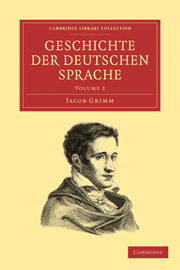Book contents
- Frontmatter
- XXI HESSEN UND BATAVEN
- XXII HERMUNDUREN
- XXIII DIE NIEDERDEUTSCHEN
- XXIV FRIESEN UND CHAUKEN
- XXV LANGOBARDEN UND BURGUNDEN
- XXVI DIE UBRIGEN OSTSTÄMME
- XXVII SCANDINAVIEN
- XXVIII DIE EDDA
- XXIX GERMANEN UND DEUTSCHE
- XXX RÜCKBLICK
- XXXI DEUTSCHE DIALECTE
- XXXII DER ABLAUT
- XXXIII DIE REDUPLICATION
- XXXIV SCHWACHE VERBA
- XXXV VERSCHOBNES PRAETERITUM
- XXXVI DIE VOCALE DER DECLINATION
- XXXVII DER INSTRUMENTALIS
- XXXVIII SCHWACHE NOMINA
- XXXIX DER DUALIS
- XL RECHT UND LINK
- XLI MILCH UND FLEISCH
- XLII SCHLUSS
- Bemerkte druckfehler, lies
XXXVI - DIE VOCALE DER DECLINATION
Published online by Cambridge University Press: 29 August 2010
- Frontmatter
- XXI HESSEN UND BATAVEN
- XXII HERMUNDUREN
- XXIII DIE NIEDERDEUTSCHEN
- XXIV FRIESEN UND CHAUKEN
- XXV LANGOBARDEN UND BURGUNDEN
- XXVI DIE UBRIGEN OSTSTÄMME
- XXVII SCANDINAVIEN
- XXVIII DIE EDDA
- XXIX GERMANEN UND DEUTSCHE
- XXX RÜCKBLICK
- XXXI DEUTSCHE DIALECTE
- XXXII DER ABLAUT
- XXXIII DIE REDUPLICATION
- XXXIV SCHWACHE VERBA
- XXXV VERSCHOBNES PRAETERITUM
- XXXVI DIE VOCALE DER DECLINATION
- XXXVII DER INSTRUMENTALIS
- XXXVIII SCHWACHE NOMINA
- XXXIX DER DUALIS
- XL RECHT UND LINK
- XLI MILCH UND FLEISCH
- XLII SCHLUSS
- Bemerkte druckfehler, lies
Summary
Ich gehe auf ein ganz andres feld über, um an neuem, noch unversuchtem beispiel die gewalt des ablauts darzulegen.
Schon s. 274 wurde gesagt, dass die trilogie A I U, auf deren grundlage alle ablaute ruhen, auch die flexion meistere; es entspringen nach ihr jedesmal drei declinationen des nomens, sowol des substantivischen als adjectivischen.
Unter den drei kurzen vocalen ist A der edelste, unentbehrlichste und allgemeinste, er waltet gleichsam von selbst, und begleitet, auch wo er ungeschrieben bleibt, die consonanz; man kann sagen, obschon unsicbtbar wird er hörbar. Wie die älteste schrift ganz ohne vocale war, die der leser den gesetzten consonanten hinzufügte, lässt auch das sanskrit jedes nach consonanten in und auslautende A unbezeichnet, während dem bestimmteren I und U bereits zeichen verliehen sind: A folgt den consonanten an sich mit. Diesem gesetz angemessen ist noch, dass in der gothischen wortableitung zwischen muta und liquida das A gewöhnlich nicht geschrieben wird, I und U aber in gleicher lage ausgedrückt erscheinen; es heisst agl (aglaitei) tagl stikls fugls tagr akrs figgrs bagms aþn, wahrscheinlich auch magn vis, vagns currus, hingegen ubils mikils ragin faginô hakuls hvôftuli fairguni. In solchen fällen pflegt nun die ahd. sprache auch das A zu schreiben, dessen nothwendigkeit zugleich aus der von ihm gewirkten brechung des I und U erhellt: akaleizî zakal stëchal fokal zahar achar finkar makan wakan, wie michil rekin hachul.
- Type
- Chapter
- Information
- Geschichte der deutschen Sprache , pp. 911 - 926Publisher: Cambridge University PressPrint publication year: 2009First published in: 1848



